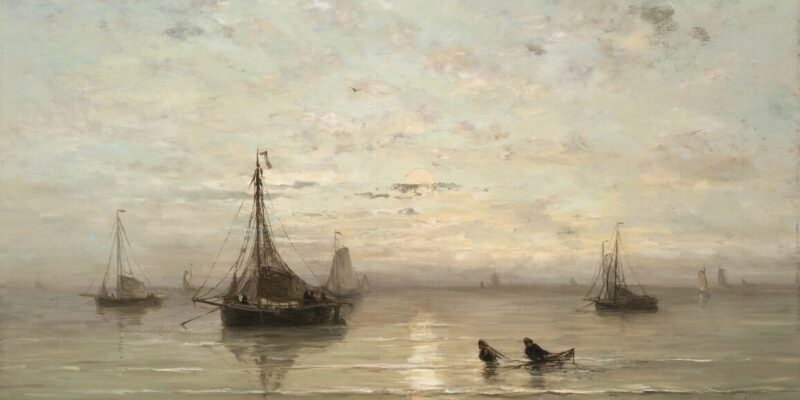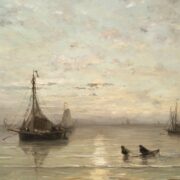The Netherlands has long been a beacon of artistic brilliance, particularly during the Golden Age of the 17th century when **famous Dutch painters** emerged to redefine the landscape of art. These artists not only showcased exceptional technical skill but also conveyed deep human emotion and societal reflections through their masterpieces. From portraits and still lifes to historical narratives, the works of these legendary painters continue to resonate with audiences today. In this article, we will explore ten unforgettable masterpieces by **famous Dutch painters**, diving into their historical significance and artistic techniques.
The Night Watch by Rembrandt van Rijn
Rembrandt van Rijn, arguably the most renowned of **famous Dutch painters**, created *The Night Watch* in 1642. This monumental painting, measuring over 12 feet wide, depicts a company of Amsterdam’s civil militia in a dramatic, lively scene. Unlike traditional group portraits of the time, Rembrandt chose to capture a moment of action, which brings the figures to life.
The use of chiaroscuro—strong contrasts between light and dark—highlights the commanding figure of Captain Frans Banning Cocq, who is giving orders to his men. This innovative approach to composition, combined with the rich color palette, not only showcases Rembrandt’s technical prowess but also signifies the importance of civic pride in Dutch society. Today, *The Night Watch* is housed in the Rijksmuseum in Amsterdam, where it attracts millions of visitors eager to witness the genius of this **famous Dutch painter**.
The Girl with a Pearl Earring by Johannes Vermeer
Johannes Vermeer is another name synonymous with the **famous Dutch painters** of the Golden Age. His masterpiece, *The Girl with a Pearl Earring*, painted around 1665, is often referred to as the “Mona Lisa of the North.” The painting features a young girl adorned in exotic attire, turning her head over her shoulder to gaze directly at the viewer, creating an intimate connection.
Vermeer’s masterful use of light and color breathes life into this piece, particularly through the luminous pearl earring that catches the light. The simplicity of the background enhances the focus on the girl, making her expression all the more captivating. Displayed at the Mauritshuis in The Hague, this enchanting work continues to draw attention for its exquisite beauty and mystery, solidifying Vermeer’s legacy as one of the most beloved **famous Dutch painters**.
The Anatomy Lesson of Dr. Nicolaes Tulp by Rembrandt van Rijn
Returning to Rembrandt, we encounter another significant work: *The Anatomy Lesson of Dr. Nicolaes Tulp* (1632). This painting is not merely an academic study but a theatrical representation of a public dissection, which was a critical educational practice of the time. Dr. Tulp, a prominent physician, is depicted demonstrating the dissection of a cadaver to a group of captivated onlookers.
The composition reveals Rembrandt’s exceptional ability to convey emotion through expression and posture. Each figure is uniquely engaged in the lesson, from the intense focus of Dr. Tulp to the curiosity and intrigue of his colleagues. The stark realism of the cadaver juxtaposed with the lively interaction of the viewers makes this piece both educational and evocative. Housed in the Mauritshuis, it stands as a testament to Rembrandt’s status as one of the foremost **famous Dutch painters**.
The Milkmaid by Johannes Vermeer
Another masterpiece by Johannes Vermeer, *The Milkmaid* (circa 1658-1660), is a stunning depiction of domestic life. The painting captures a young woman pouring milk into a bowl, surrounded by a warm, inviting kitchen scene filled with various utensils and food items.
Vermeer’s meticulous attention to detail and his exquisite use of light transform a simple act into an extraordinary moment. The vibrant colors and the play of light across the milkmaid’s face and clothing create a sense of depth and realism that is characteristic of Vermeer’s work. This painting celebrates the beauty of everyday life and remains one of the most beloved works of **famous Dutch painters**, proudly displayed at the Rijksmuseum.
The Laughing Cavalier by Frans Hals
Frans Hals is celebrated for his lively portraits, and *The Laughing Cavalier* (1624) exemplifies his dynamic style. This painting features a young man dressed in extravagant attire, complete with a wide-brimmed hat and an infectious smile. Hals’s ability to capture personality and movement is evident in the cavalier’s animated expression and relaxed pose.
The painting is notable for its bold use of color and brushwork, which create a sense of spontaneity. Unlike many of his contemporaries, Hals eschewed the rigid formalities of portraiture, opting instead to portray his subjects with vitality and warmth. *The Laughing Cavalier* is currently housed in the Wallace Collection in London, where it captivates audiences as one of the finest works by **famous Dutch painters**.
The Night Watch by Rembrandt van Rijn
Rembrandt van Rijn, known for his remarkable skill in capturing light and shadow, created *The Night Watch* in 1642. This iconic work is a group portrait of the Amsterdam militia and is notable for its dynamic composition. Unlike traditional group portraits that often appear static, Rembrandt’s innovative approach creates a sense of movement and excitement.
The painting features Captain Frans Banning Cocq and his lieutenant, Willem van Ruytenburch, leading their men. The use of dramatic lighting highlights specific figures while casting others into shadow, adding depth and intrigue to the scene. *The Night Watch* remains one of the most famous works of **famous Dutch painters**, symbolizing the pride and spirit of the Dutch people during the Golden Age. Today, it is prominently displayed in the Rijksmuseum in Amsterdam, drawing countless art enthusiasts.
The Staalmeesters by Frans Hals
Another masterpiece by Frans Hals, *The Staalmeesters* (1662), is a remarkable group portrait that depicts the administrators of the Haarlem Cloth Guild. This painting captures the men in a moment of discussion, showcasing their authority and camaraderie.
Hals’s skill in portraying individual personalities shines through in this work, as each figure is rendered with distinct facial expressions and postures. The warm color palette and dynamic composition create an engaging atmosphere, inviting viewers to connect with the subjects. This masterpiece is considered a prime example of Hals’s brilliance and is housed in the Frans Hals Museum in Haarlem, further establishing his place among the **famous Dutch painters**.
The Procuress by Frans van Mieris
Frans van Mieris, a lesser-known but significant figure among **famous Dutch painters**, created *The Procuress* in 1662. This captivating work depicts a scene in a dimly lit tavern, where a young woman is being presented to a man by a matronly figure. The composition captures a moment of intrigue and seduction, highlighting the interplay of light and shadow.
Van Mieris’s attention to detail is evident in the rich textures of the clothing and the intricate objects in the background. The warm tones and atmospheric lighting create a sense of intimacy, inviting viewers to ponder the narrative unfolding within the scene. *The Procuress* is a stunning representation of genre painting and is housed in the Rijksmuseum, further illustrating the diversity of talent among **famous Dutch painters**.
The Arnolfini Portrait by Jan van Eyck
While Jan van Eyck is often associated with the Northern Renaissance, his influence permeated the works of many **famous Dutch painters**. The *Arnolfini Portrait* (1434) is one of his most celebrated masterpieces, depicting a wealthy couple in their home. The painting is renowned for its exquisite detail, particularly in the textures of clothing and the intricate reflections in the convex mirror.
The symbolism embedded within the composition invites various interpretations, making it a fascinating subject of study. Van Eyck’s innovative use of oil paint allows for a remarkable depth of color and realism, setting a precedent for future generations of artists. This masterpiece is housed in the National Gallery in London, serving as a reminder of Van Eyck’s pivotal role in the evolution of Dutch painting.
S
No exploration of **famous Dutch painters** would be complete without mentioning Vincent van Gogh. His *Self-Portrait* (1889) showcases the emotional depth and intensity that characterize his work. Painted during his time at the Saint-Paul-de-Mausole asylum in Saint-Rémy-de-Provence, this piece reflects Van Gogh’s struggle with mental illness and his passion for art.
The bold brush strokes and vibrant colors convey a sense of urgency and emotion, drawing viewers into Van Gogh’s world. His unique style has had a profound impact on modern art, influencing countless artists and movements. This *Self-Portrait* is a powerful testament to Van Gogh’s legacy and is part of the collection at the Van Gogh Museum in Amsterdam, where it continues to inspire and move audiences.
Conclusion
The contributions of these **famous Dutch painters** to the world of art are nothing short of extraordinary. Through their innovative techniques and captivating compositions, they have created timeless masterpieces that continue to resonate with audiences today. From the dramatic scenes of Rembrandt to the intimate portraits of Vermeer, each painting tells a unique story, inviting us to reflect on the beauty and complexity of the human experience.
FAQs
Q1. What is the significance of the Dutch Golden Age in art history?
The Dutch Golden Age, which occurred during the 17th century, was a period of great cultural and artistic achievement in the Netherlands. It is characterized by a flourishing of the arts, particularly painting, where artists developed new techniques and styles, resulting in some of the most celebrated works in Western art.
Q2. How did Rembrandt influence the art world?
Rembrandt’s innovative use of light and shadow (chiaroscuro), his focus on human emotion, and his ability to portray character depth significantly influenced subsequent generations of artists. His techniques laid the groundwork for the development of modern painting.
Q3. What themes are commonly found in Dutch genre paintings?
Dutch genre paintings often depict scenes of everyday life, focusing on domestic interiors, social gatherings, and interactions among people. Common themes include leisure activities, moral lessons, and the contrasts between different social classes.
Q4. What materials and techniques did Dutch painters use?
Dutch painters primarily used oil paints on canvas, which allowed for rich colors and detailed textures. They also employed techniques such as glazing, layering, and impasto to achieve depth and vibrancy in their works.
Q5. Where can I view these masterpieces today?
Many of the masterpieces created by these renowned artists can be found in major museums in the Netherlands, such as the Rijksmuseum in Amsterdam, the Mauritshuis in The Hague, and the Van Gogh Museum, as well as various international collections around the world.
Also read: Oud West Neighborhood Amsterdam: 10 Unforgettable Experiences to Try












